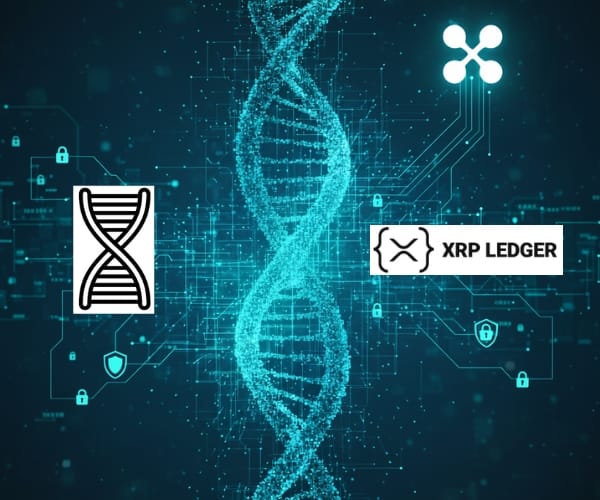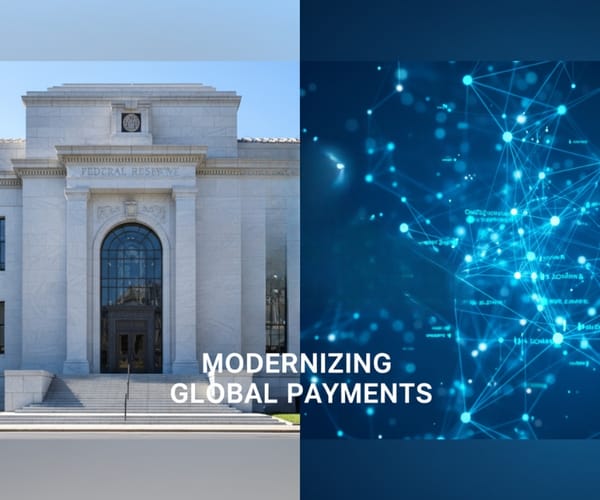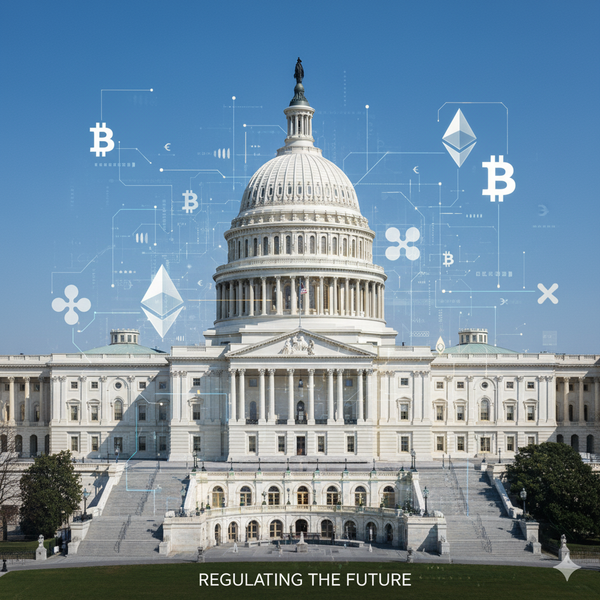XRP Ledger Powers World's First Blockchain-Based Genomic Identity System: DNA Protocol
DNA Protocol launches world's first blockchain genomic identity system on XRP Ledger. Zero-knowledge privacy technology enables genetic verification without exposing DNA data. Revolutionary BioFi applications include health passports, biometric KYC, and genomic insurance.

DNA Protocol has launched the world's first operational blockchain-based genomic identity verification system, transforming the XRP Ledger from a payments network into a secure anchor for human biological data. The platform's innovative Genomic Hash Mesh represents a paradigm shift in how genetic information is stored, verified, and controlled.
We are building next-gen Identity Governance & Access Management tools on the #XRPL — ensuring trust, security, and the safety of your digital identity. pic.twitter.com/9BonC4LKHX
— DNA Protocol (@DNAOnChain) September 14, 2025
Revolutionary Zero-Knowledge Privacy Goes Live
In an X post, Pumpius revealed that ZK privacy is now live on the XRP Ledger, through the DNA protocol. He stated that this was massive as it means that network users, including Ripple's partners, can now prove something is true on the ledger, such as KYC, without exposing their private data. This development marks a significant milestone for both privacy technology and the practical applications of blockchain in healthcare.
The system enables users to prove identity, asset ownership, or compliance status without revealing sensitive personal information. Pumpius further explained that XRP Ledger users can prove they own an asset or that they passed a KYC, or that a transaction is valid, without showing their private details to anyone.
Technical Architecture: How Genomic Hash Mesh Works
DNA Protocol described the Genomic Hash Mesh as a decentralized network designed to validate DNA-based identities. Rather than storing sensitive information, the system uses zk-differential compression to hash genome data into a verifiable format.
The technical implementation involves several key components:
Zero-Knowledge Compression: Raw DNA sequences are converted into cryptographic hashes using zero-knowledge differential compression, ensuring genetic data never exists in readable form on-chain.
Merkle-Linked Attestation: Nodes then confirm these hashed signatures through Merkle-linked attestation, providing trustless identity without centralized databases.
Real-Time Validation: Each node acts as a validator in a live mesh network, processing genomic transitions that confirm lineage, mutations, and sequence integrity.
XRPL Anchoring: The final result, cryptographic proofs, are immutably committed to the XRP Ledger. This system allows for real-time authentication while keeping raw DNA data off-chain.
Market Impact and BioFi Applications
The launch introduces what DNA Protocol calls "BioFi" - the convergence of biological identity with decentralized finance. The potential market for genetic data, valued at over $100 billion, is significant. DNA Protocol aims to shift control of this valuable data from corporations back to individuals, giving people ownership of their DNA and redefining privacy, health, and financial services.
Key applications include:
- Zero-Knowledge Health Passports: Prove health status without revealing medical details
- Biometric KYC: Financial verification using biological markers instead of documents
- Genomic Insurance: Borderless insurance products based on verified genetic risk factors
- Decentralized Clinical Trials: Secure patient matching without exposing genetic information
XRP/Ripple Analysis: Strategic Implications
Enhanced Utility Beyond Payments
Pumpius maintained that the XRP Ledger is the go-to network because it isn't a "toy blockchain." He noted that it is fast, scalable, and institutional-ready. Furthermore, with the DNA protocol and the ZK privacy update, the market commentator declared that it has become the only ledger where identity, privacy, and liquidity live together.
Technical Advantages for Biological Data
Pumpius, a crypto commentator who shared details of the launch, noted that XRP's ledger offers specific advantages. These include low transaction fees, real-time finality, and consistent global uptime. DNA Protocol leveraged these features to ensure that the Genomic Mesh remains both scalable and clinically viable.
Partnership and Adoption Potential
The integration positions XRP Ledger as the infrastructure of choice for healthcare institutions, research organizations, and governments seeking secure, compliant identity solutions. Companies, including Ripple's partners, can now prove their identity without revealing their personal data or DNA.
XDNA Token Economy and Institutional Interest
DNA Protocol launched its native XDNA token in July 2025, creating additional utility within the ecosystem. The token economics reveal a carefully structured approach to sustainable growth:
Token Specifications:
- Total Supply: 1 billion XDNA tokens
- Presale Supply: 300 million tokens (30% of total)
- Presale Price: 1 XDNA = 0.1 USDT
- Exchange Rate: 10 XDNA tokens per 1 USDT investment
Utility Functions:
- DNA record anchoring and blockchain storage fees
- Identity verification and healthcare app access
- Premium genomic analytics and health reporting
- Project governance and protocol decision-making
- Staking rewards for network validation
Institutional Attention: Speculation has emerged regarding potential institutional involvement, with crypto community discussions suggesting major financial entities like BlackRock may have indirect interest through XDNA ETF connections. While no official confirmation exists, the project's strategic positioning on XRPL and discreet presale approach have attracted significant attention from both institutional and retail investors in cryptocurrency and traditional finance circles.
Regulatory and Compliance Considerations
The timing of DNA Protocol's launch coincides with increasing regulatory focus on data privacy and genetic information protection. As concerns over personal data collection by governments and companies grow, DNA Protocol offers a timely solution by providing a way to control identity without sacrificing privacy.
The platform's zero-knowledge approach addresses key regulatory requirements:
- GDPR Compliance: No personal data stored on-chain
- HIPAA Alignment: Healthcare data remains under user control
- Genetic Non-Discrimination: Proves compliance without revealing genetic markers
Future Outlook and Market Positioning
The quiet revolution on XRPL, driven by projects like DNA Protocol and XRP Healthcare, is building foundational infrastructure for a new digital ecosystem that combines healthcare, identity, and finance on a single ledger.
The convergence of biological identity, blockchain infrastructure, and financial services represents a potential trillion-dollar market opportunity. This strategic development could become the next trillion-dollar use case for blockchain technology, evolving XRP far beyond its traditional role in payments.
As healthcare digitization accelerates and privacy concerns intensify, DNA Protocol's position as the first mover in blockchain genomics could establish XRP Ledger as the standard infrastructure for biological identity verification globally.
Key Takeaways
DNA Protocol's launch on XRP Ledger represents more than a technological milestone—it's the foundation of a new economy where individuals control their most personal data while enabling unprecedented verification capabilities. The platform transforms XRP Ledger from a payments network into a comprehensive identity infrastructure, positioning both DNA Protocol and XRP for significant growth as the BioFi sector emerges.
Sources:
- DNA Protocol Official Website
- XDNA Token Presale
- DNA Protocol Twitter
- Bitcoinist - XRP Ledger Update
- Blockonomi - Genomic Hash Mesh
- CoinTrust - XRP Genomics
DISCLAIMER: This newsletter is for informational purposes only and does not constitute investment advice, advertising, or a recommendation to buy, sell, or hold any securities. This content is not sponsored by or affiliated with any of the mentioned entities. Investments in cryptocurrencies or other financial assets carry significant risks, including the potential for total loss, extreme volatility, and regulatory uncertainty. Past performance is not indicative of future results. Always consult a qualified financial professional and conduct thorough research before making any investment decisions.



